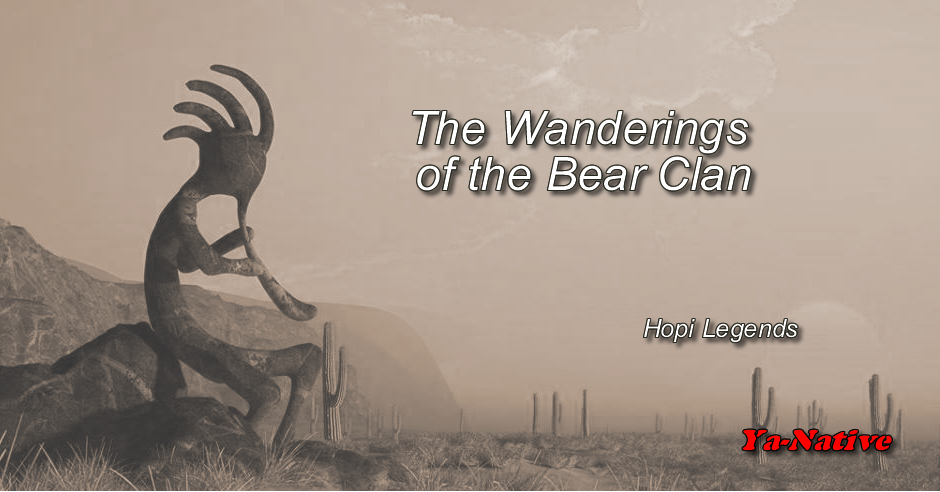
After we had left the sípahpuni the Bear people separated and went ahead of the others. First they came somewhere near the present site of Phoenix , and stayed there awhile. They remained for or shorter or longer periods at many different places. Finally they came to the Little Colorado River, and about there it was where they assumed the clan name, but just exactly where the place was nobody can tell. Their forefathers say that the party once came upon a dead bear that they looked at, and from that they were called forever afterwards the Bear clan. Another party that traveled with them took the hide of the bear, of which the hair had already been removed by little animals (Mû'yi. Pl. Mû'mutyu), who use hair or wool for their nests or burrows.
These people took the skin and cut from it carrying straps (piqö'sha), from which they were called Piqö'sha clan. Another party came upon the bear at just this time and were called Mû'yi clan, after the small mice mentioned before. These three clans arrived there just about the same time, and hence are considered as closely related to one another. Shortly after another party passed by and found many blue-birds sitting upon the cadaver eating from it; so they were called the Bluebird clan (Chórzh-ñamu). Still later another party, came upon the scene and found the remains of the cadaver full of spider web, so this party was called Spider (Kóhk'ang) clan. By and by a sixth migrating party came along.
By this time the bones of the bear were bleached already. They took the skull, tied yucca leaves to it and carried it along as a drinking vessel in the manner in which the chief's or priest's jugs (móngwikurus) are carried at the present time, and from this. that party was called the jug (Wíkurzh) clan. Finally a seventh party came along and found the place where the bear had been killed swarming with ants, so they were called the Ant (Án- ñamu) clan.
These seven clans have derived their names from the same origin, and are now considered as being related to one another. The Bear clan is also said to have halted at various places along the Little Colorado River. From there they moved eastward, stopping for some time at a place called Badger Spring (Honánva).
From this place they again moved eastward, stopped at a place called Mákwutavi, and from here they finally moved to Matö'ví, a large spring a number of miles south of Shongópavi. At this place they also remained for a considerable length of time, but finally they moved northward to the present site of Shongópavi, where they remained. They being the first to arrive at this place, they have ever since considered themselves to be the leading clan in the village, the village chief having also been chosen from their clan.
A few persons of the Bear clan moved from here to Oraíbi, where the chieftainship of the 264 so-called Liberal or Friendly faction is still held by that clan, the Conservative or Hostile faction of that village selecting their chief from the Spider clan. Two of this clan moved to the villages of Shupaúlavi and Mishóngnovi, where the office of the village chief has also remained in this clan to the present day.
The Bear clan brought with them the altar paraphernalia, song, etc., of the Blue Flute cult. When they stopped and planted anywhere they would perform the Blue Flute ceremony and sing the songs, and their crop would then grow and mature very quickly, so that they would have something to eat. They also brought with them the Hû Katcina, the Bear (Hon) Katcina, the Â'ototo Natácka, his wife Cóoyok Wuhti, and finally the Cóoyoko Táhaam.
Later on other clan and migrating parties arrived at Shongópavi asking of the Bear clan admission to the village. If proper arrangements could be made with the Bear clan they remained; if not, they moved on. Many of the large and small ruins with which the country is covered date back to the time of the migration of these different clans, showing the places where they made stays of shorter or longer duration.
A Hopi Legend
H. R. Voth, 1905